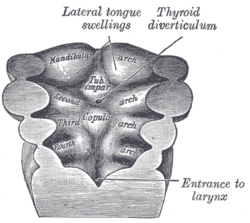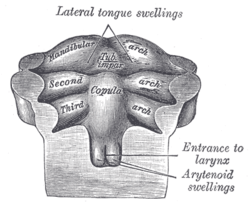Lateral lingual swelling
From Wikipedia, the free encyclopedia
| Lateral lingual swelling | |
|---|---|
 | |
| Floor of pharynx of human embryo about twenty-six days old. | |
 | |
| Floor of pharynx of human embryo of about the end of the fourth week. | |
| Latin | tuberculum linguale laterale |
| Gray's | p.1102 |
| Code | TE E5.4.1.2.0.0.5 |
During the third week there appears, immediately behind the ventral ends of the two halves of the mandibular arch, a rounded swelling named the tuberculum impar, which was described by His as undergoing enlargement to form the buccal part of the tongue. More recent researches, however, show that this part of the tongue is mainly, if not entirely, developed from a pair of lateral swellings (or distal tongue bud) which rise from the inner surface of the mandibular arch and meet in the middle line.
External links
- lateral+lingual+swelling at eMedicine Dictionary
- hednk-024 — Embryo Images at University of North Carolina
This article incorporates text from a public domain edition of Gray's Anatomy.
| |||||||||||||||||||||
This article is issued from Wikipedia. The text is available under the Creative Commons Attribution/Share Alike; additional terms may apply for the media files.